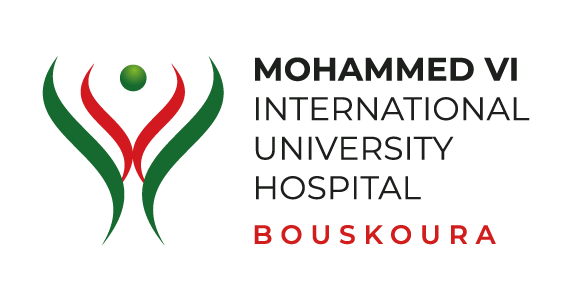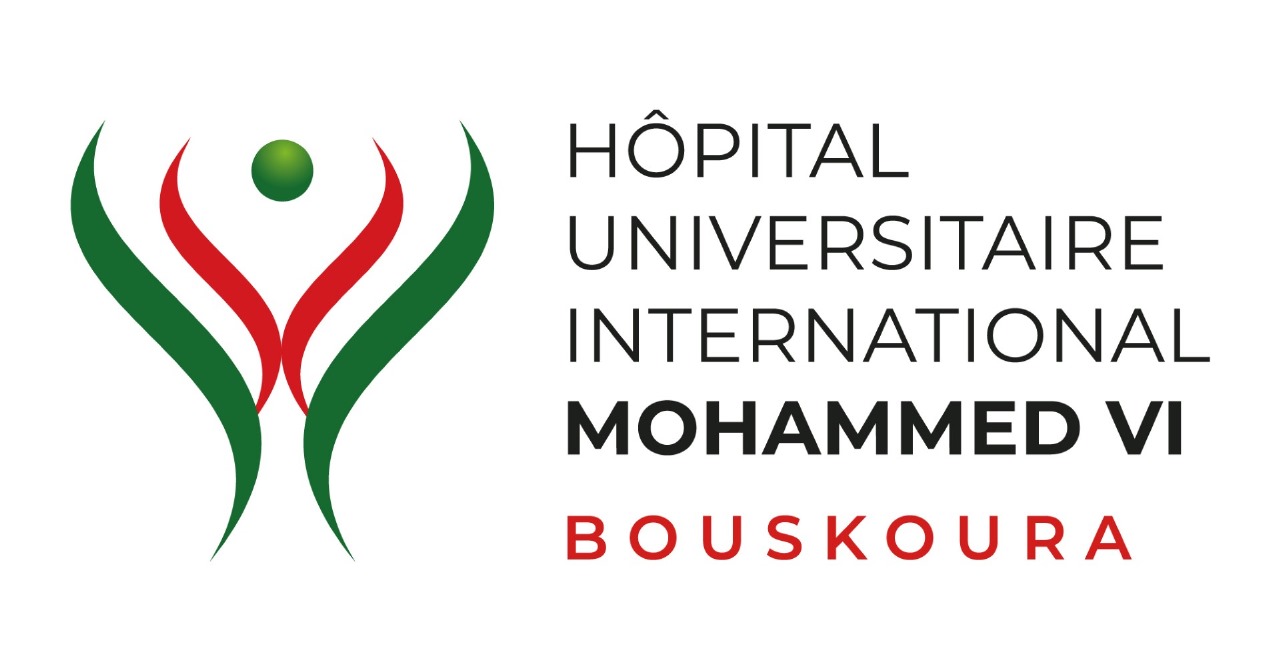The Mohammed VI International University Hospital offers various surgical disciplines, based on a team of experienced and efficient surgeons, surrounded by multidisciplinary teams and supported by state-of-the-art equipment to meet the needs of the patient population.
- Skin biopsy
- Excisional biopsy of tumor lesions
- Nail surgery:
- Ingrown nail
- Subungual tumors
- Removal of sebaceous cysts
- Electrocoagulation of skin lesions
- Bariatric surgery
- Colorectal surgery
- Hepato-bilio-pancreatic surgery
- Esophagogastric surgery
- Wall surgery
- Endocrine surgery
- Proctology surgery
- Cancer surgery
- Visceral emergencies
- Breast surgery: conservative surgery and modern surgery for breast pathologies
- Stress urinary incontinence surgery: strip treatment or minimally invasive approach
- Surgery for pelvic floor disorders by laparoscopic, natural or mixed route: genital, bladder or rectum prolapse
- Laparoscopic surgery: laparoscopic promontofixation
- Surgery under hysteroscopy of uterine pathologies: uterine fibroids, uterine polyps, uterine synechiae, endometriectomy, tubal sterilization
- Hysteroscopic or laparoscopic fibroma surgery
- Cervical surgery (laser conization)
- Total or subtotal hysterectomy with or without ovarian conservation, by hysteroscopy or laparoscopy
- Ovarian surgery: removal of cysts and tumors
- Fertility surgery: tubal plastic surgery, destruction of endometriosis, removal of adhesions…
- Surgery for pelvic endometriosis
- Plastic surgery
Note that in some cases, RCPs (Multidisciplinary Consultation Meetings) are held for optimal patient care.
- Cataract surgery by phacoemulsification (Adult)
- Congenital cataract surgery (in children)
- Refractive surgery (PKR, LASIK, phakic implant)
- Cornea transplant
- Amniotic membrane transplant
- Strabismus surgery
- Eyelid and lacrimal tract surgery
- Pterygium and Chalazion Surgery
- Vitreoretinal surgery
- Cross linking and intracorneal rings.
- Glaucoma filter surgery
OTOLOGY
- Ear surgery in children and adults (Tympanic aerators, tympanic perforation, chronic cholesteatomatous and non-cholesteatomatous ear infections, otosclerosis, pathology of the ossicles, malformations, etc.)
- Endoscopic and CO2 laser ear surgery
- Surgery and stereotactic radiotherapy of vestibular schwa nomes (or neuromas), in partnership with the neurosurgery and radiotherapy departments.
RHINOLOGY
- Video-endoscopic surgery of the nose and sinuses
- Endoscopic skull base surgery in collaboration with the neurosurgery team
LARYNX PATHOLOGIES
- Laser microsurgery (endoscopic) of the vocal cords
BUCCO-PHARYNGEAL PATHOLOGIES
- Tonsillectomies in children and adults
- Removal of adenoids (Adenoidectomy)
NECK PATHOLOGIES AND CERVICAL SURGERY
- Thyroid gland surgery (nodules and goiters)
- Surgery of the parathyroid glands (parathyroid adenomas)
- Surgery for cervical cysts and fistulas in children and adults (thyroglossal duct cyst, cystic lymphangioma, etc.)
- Cervical tumor surgery (adenopathy, schwa nome, paraganglioma, etc.)
- Surgery for skin tumors of the face and neck
- Reconstructive surgery of the face and neck
CANCEROLOGY
- Endoscopic endo-nasal and Trans-oral surgery
- CO2 laser surgery
DIZZINESS AND VESTIBULAR REHABILITATION
- Medical and surgical treatment of peripheral vertigo
FACIAL PARALYSIS
- Surgical rehabilitation of facial paralysis
MANAGEMENT OF SNORING AND SLEEP APNEA (OSAS)
- Medical and surgical treatment of snoring and sleep apnea
SKIN PATHOLOGIES OF THE FACE AND NECK
- Surgery for benign skin tumors of the face and neck
- Cervicofacial skin cancer surgery
- Laser surgery
MAXILLO-CERVICO-FACIAL TRAUMATOLOGY
- Management of fractures and trauma to the face and neck (fractured nose, mandible, orbit, malar, sinus and larynx)
- Fractures of the anterior level of the base of the skull and cerebrospinal rhinorrhea in collaboration with the neurosurgery department within the framework of the Trauma-center
ENT RESTORATIVE SURGERY
- Septoplasty, rhinoplasty and rhino septoplasty
- Otoplasty (surgery of protruding ears)
- Joint surgery: hip, knee, ankle, shoulder, elbow, wrist…
- Hand surgery
- Peripheral nerve surgery
- Spinal surgery
- Foot surgery
- Arthroscopy
- Surgery for the after-effects of trauma.
Pediatric surgery draws its particularity from the great variety of pathologies of surgical interest in the pediatric population, from children born prematurely to adolescents. It is separated into two disciplines: pediatric visceral surgery and pediatric orthopedics.
PEDIATRIC VISCERAL SURGERY
It concerns the urinary, digestive and thorax systems.
Urological pathology concerns the kidney (total nephrectomy, partial nephrectomy of dual systems, etc.), the upper urinary tract (cure of syndromes of the pyelo-ureteral junction, surgery of the ureter, endo-urology, etc.), surgery of the bladder (vesico-ureteral reimplantation and endo-urology, etc.) and the external genital organs (surgery of the hypospadias, of the testicle,etc. ).
The digestive aspect concerns esophageal pathology (oesophageal atresia), gastric (anti-reflux surgery), hepatobiliary (biliary atresia, bile duct cyst, etc.)), intestinal (appendectomy, bowel or colic atresia, bowel volvulus, acute intestinal intussusception) without omitting the very frequent surgery of the inguinal hernia by persistence of the peritoneal-vaginal canal.
The approach of the thorax allows the realization of lobectomy, tumorectomy…
PEDIATRIC ORTHOPEDIC SURGERY
Pediatric orthopedics deals with scoliosis surgery, upper limb and lower limb. Hand surgery falls within the competence of the pediatric orthopedist.
PEDIATRIC PLASTIC SURGERY “the 3rd discipline”
Pediatric plastic surgery is intended for newborns, young children and adolescents with congenital anomalies of the skin, head and neck and limbs, but also for acquired anomalies of the skin tissues of traumatic or tumoral origin.
Reconstructive surgery
Reconstructive surgery corrects certain congenital or acquired deformities (after a trauma, a surgical resection for cancer, a burn for example). It allows the treatment of the following pathologies or interventions :
- Breast reconstruction after cancer,
- After-effects of burns and accidents (scars and loss of substance),
- Ulcers and bed sores.
Plastic Surgery
Plastic surgery allows the treatment of the following pathologies or interventions :
- Breast pathologies (breast hypertrophy, breast deformity, breast asymmetry, benign breast tumor…),
- Belly surgery (abdominoplasty),
- Thigh lift (cruroplasty), arm lift (brachioplasty),
- Surgery of benign or malignant skin and soft tissue tumors (muscular and connective tissue) (children and adults),
- Surgery for protruding ears (otoplasty).
Thoracic surgery includes all pathologies affecting the lung, pleura, mediastinum, trachea and chest wall.
It supports tracheobronchial, pulmonary, mediastinal, pleural, parietal pathologies whether they are of benign or malignant tumor origin, progressive or sequella infectious, or malformative .
Among the thoracic surgeries:
- Tracheal surgery (carina, ECMO);
- Surgery for thoracic deformities;
- Lung volume reduction surgery;
- Thorax reconstructive surgery and thoracomyoplasties.
Vascular surgery treats diseases of the arteries, veins and vessels of the chest, arms and legs. The arteries of the neck (carotids), the abdominal aorta, as well as the superficial (varicose veins) and deep venous network of the lower limbs are concerned in priority. Vascular surgery can repair a narrowing – thickening of the atherosclerotic plaque, due to excess cholesterol –, a continuous or very localized dilation (aneurysm) or an obstruction, stenosis or thrombosis affecting arteries and veins.
After radiological exploration, the vascular surgeon uses, in association or not with a drug treatment, two main ways of intervention:
- Endovascular treatment: The instruments are introduced through the interior of a vein or an artery to perform angioplasty, for example (dilation of an artery, placement of an endoprosthesis, etc.);
- Conventional open surgery: Either it intervenes in a conventional way if the lesion is large or located beyond the reach of the endovascular process, to perform a bypass for example.
Between the two, new so-called minimally invasive surgery techniques are being developed, allowing an intervention with a very small entry point, thereby reducing the duration of remission, complications and the risk of residual scarring.
Neurosurgery allows the treatment of the following pathologies or interventions :
- The herniated disc
- Pituitary adenoma
- Hydrocephalus
- Head trauma
- Trauma to the spine with vertebral fractures
- Brain and cerebellum tumor
- Intramedullary tumor
- Intracranial aneurysm
- Meningeal hemorrhage
- Parkinson’s disease
- Peripheral nerve surgery
- Craniopharyngioma
- Neurofibromatosis
- Surgical treatment of cerebral ischemia
- Hyperacusis
- Pediatric neurosurgery
- Craniocerebral and extraparenchymal tumors
- Spinal and spinal cord injuries and nerve wounds
- Non-traumatic radiculo-medullary pathologies
- Cerebral vascular malformations.




